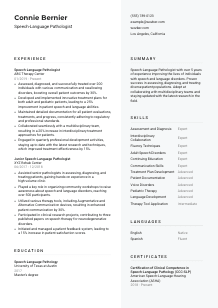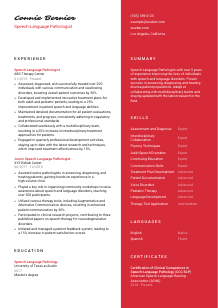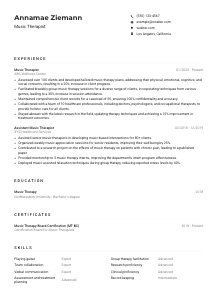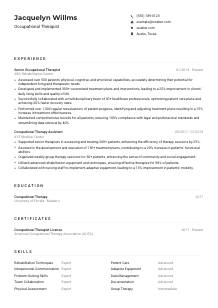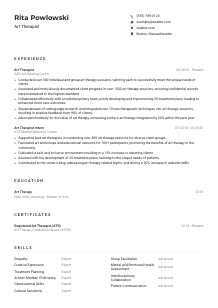Speech-Language Pathologist Resume Example
Unraveling communication quandaries, but your resume doesn't articulate your expertise? Audition this Speech-Language Pathologist resume example, fashioned with Wozber free resume builder. Discover how to voice your interventions in sync with job expectations, ensuring your career story resonates as clearly as your clients' speech.
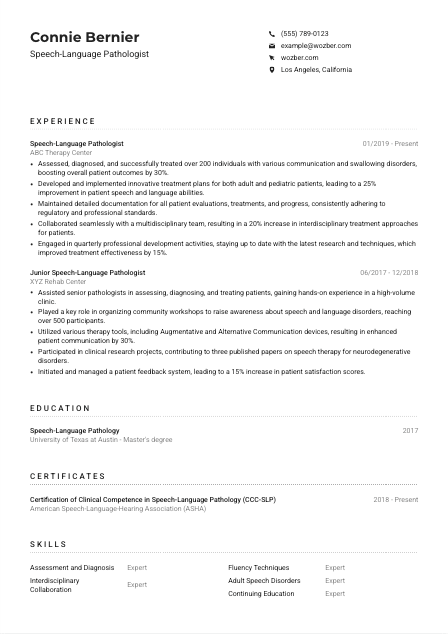
How to write a Speech-Language Pathologist Resume?
Hey there, future communication champion! If you're ready to leap into the world of Speech-Language Pathology with a resume that not merely speaks but sings your praises, you've come to the right place. With the tight competition out there, having a resume that resonates with the job description and dances through Applicant Tracking Systems (ATS) isn't just nice to have—it's essential. And guess what?
You're about to carve your path with precision. Using the Wozber free resume builder, this guide will be your beacon, illuminating the steps to tailor your resume like a pro. Whether you're smoothing out speech ripples or unlocking new ways of communication, let's ensure your resume reflects the difference you're set to make.
Personal Details
Your introduction on your resume is not just a formality—it's your first hello, your digital handshake. Let's fine-tune your personal details to ensure you're showcasing a professional yet personable image right off the bat. Tailoring this section to a Speech-Language Pathologist role means more than just getting your name on there; it's about carving a niche for yourself at first glance.
1. Make Your Name Shine
Consider your name your personal brand's logo. Does Apple mumble its name? Never! So, your name should be clear, bold, and the anchor of your resume. Playing with font size is fine, but keep clarity as your guiding star. A well-presented name sets the stage for the quality and professionalism of the Speech-Language Pathologist you are.
2. Title Alignment Is Key
Right beneath your name, echo the title 'Speech-Language Pathologist'. This is no time for creative job titles—stick to what's sought. It's about creating an immediate connection with the hiring manager by showing you're exactly what they're looking for, at a single glance.
3. Your Contact Info, Crystal Clear
Let's make sure they have a way to say 'Hello back!' A professional email that's a variation of your name and a current phone number without the fear of typos make you reachable. Remember, in the digital world, an unreadable contact is a lost opportunity.
4. Location Matters
For a role anchored in Los Angeles, California, making your location clear is crucial. It signals to the employer you're community-oriented and understand the local dialects and cultures—a must-have soft skill for any Speech-Language Pathologist.
5. Trim the Excess
Your age, marital status, or favorite color might be interesting, but they're not getting you the job. Keep personal details professional and relevant. In a world that values privacy, offering only what's necessary is both a professional and a personal win.
Takeaway
Think of your personal section as the window display of your professional shop. It's neat, enticing, and tells the world, ‘Here lives a Speech-Language Pathologist ready for the next big challenge.' Keep it professional, make it shine, and let it echo the essence of the role you're yearning to fill.





Experience
Here, we dive deep into the heart of your resume—the experience section. Every role you've played has prepared you for this moment. Let's ensure each word validates you as the exceptional Speech-Language Pathologist candidate you are, echoing the responsibilities and triumphs that align with the job you desire.
- Assessed, diagnosed, and successfully treated over 200 individuals with various communication and swallowing disorders, boosting overall patient outcomes by 30%.
- Developed and implemented innovative treatment plans for both adult and pediatric patients, leading to a 25% improvement in patient speech and language abilities.
- Maintained detailed documentation for all patient evaluations, treatments, and progress, consistently adhering to regulatory and professional standards.
- Collaborated seamlessly with a multidisciplinary team, resulting in a 20% increase in interdisciplinary treatment approaches for patients.
- Engaged in quarterly professional development activities, staying up to date with the latest research and techniques, which improved treatment effectiveness by 15%.
- Assisted senior pathologists in assessing, diagnosing, and treating patients, gaining hands‑on experience in a high‑volume clinic.
- Played a key role in organizing community workshops to raise awareness about speech and language disorders, reaching over 500 participants.
- Utilized various therapy tools, including Augmentative and Alternative Communication devices, resulting in enhanced patient communication by 30%.
- Participated in clinical research projects, contributing to three published papers on speech therapy for neurodegenerative disorders.
- Initiated and managed a patient feedback system, leading to a 15% increase in patient satisfaction scores.
1. Match It Up
First things first. Break out a highlighter (digital or old-school), and underline key responsibilities and accomplishments in the job description. Did you assess and treat over 200 individuals? There's your golden nugget! It's like matching puzzle pieces; make sure your achievements fit perfectly in the picture the job description paints.
2. The Structure That Holds
Keep the flow logical and easy to follow—start with your current or most recent role and work backward. Each entry should clearly list your title, the name of the facility, and the dates you were there. This structure isn't just for clarity; it's for the ATS to easily navigate your career journey. Remember, if the ATS can't read it, neither will human eyes.
3. Achievements That Speak Volumes
"Assessed, diagnosed, and successfully treated over 200 individuals" isn't just a statement; it's a story of impact and capability. Whenever you can, quantify your accomplishments. Numbers speak louder than adjectives. They provide tangible proof of your effectiveness and dedication.
4. Relevance Is Your Compass
Your hobby of collecting stamps, while fascinating, might not help land you the role. Stick to the script—the job description's script, that is. Every point you make should be a response to a requirement or responsibility listed by the employer. It's about them seeing you in the role before they even meet you.
5. Embrace Your Unique Contributions
While aligning with the job requirements, don't forget to sprinkle your unique spice. Did you introduce an innovative treatment plan? Lead a community outreach for awareness? That's your personal flavor, and it makes your application memorable. Tailor your resume but keep it authentically you.
Takeaway
Each entry in your experience section contributes to the narrative of you as the ideal Speech-Language Pathologist. This is where your professional past helps to solidify your future. Tailor it, keep it relevant, and let your success stories resonate with the needs of the potential employer. You're not just listing jobs; you're showcasing a journey of growth, impact, and dedication.
Education
In the realm of Speech-Language Pathology, your academic credentials are the bedrock of your expertise. This section isn't just a formality; it's evidence of your foundational knowledge and commitment to this noble profession. Let's sculpt your education history to reinforce your candidacy for the role.
1. Align with The Essentials
The job description called for a "Master's degree in Speech-Language Pathology from an accredited institution." If your education ticks this box, place it front and center. It's not just a degree; it's a direct match to a crucial requirement.
2. Clarity Is Non-negotiable
Degree, field of study, institution, and graduation year—all straightforward and easy to find. This isn't the place for narratives; it's the place for facts. Your educational qualifications should be as clear and digestible as possible, making it easy for both ATS and hiring managers to verify your credentials.
3. The Job-Specifics
For Speech-Language Pathology, specifics matter. Your degree in the field is your ticket in. If you've specialized further or have taken courses directly relevant to the role you're applying for, this is the moment to showcase them. Tailor your education section to reflect the specialized knowledge the job seeks.
4. Beyond The Books
If your academic journey includes honors, awards, or extracurricular activities that highlight your leadership, commitment, or relevancy to Speech-Language Pathology, don't hold back. Especially for early-career professionals, these details can illuminate personal qualities that academics alone can't.
5. Lifelong Learner
Your formal education might have set the stage, but the learning never stops, especially in a field as dynamic as Speech-Language Pathology. If you've taken part in workshops, seminars, or other relevant continuing education efforts post-graduation, letting them take a bow in this section underlines your commitment to staying at the forefront of your profession.
Takeaway
Your education section is proof of the rigorous groundwork you've invested in becoming a Speech-Language Pathologist. It's the solidity on which your professional achievements stand. Present it proudly, tailor it to echo the job's academic requisites, and let it serve as irrefutable evidence of your readiness and qualification for the role.
Certificates
In the world of Speech-Language Pathology, certifications aren't just add-ons; they're indicators of your expertise and dedication to standards of excellence. Let's illuminate how to leverage your certifications to elevate your resume and resonate with the specific job requirements.
1. Identify The Must-Haves
The job description explicitly mentions "ASHA Certification of Clinical Competence in Speech-Language Pathology (CCC-SLP)." This is non-negotiable, a must-have that must stand out on your resume. Positioning this certification prominently is like displaying a badge of honor—it speaks volumes about your qualifications.
2. Quality Over Quantity
Listing every workshop you've ever attended can be tempting, but it dilutes the impact of the truly significant ones. Focus on the certifications that align closest with the job specifics. Think of it as curated display of your most relevant accolades.
3. Dates Matter
Certifications have timelines, and in professions as important as Speech-Language Pathology, being current is vital. Specify the validity of your certifications where applicable. It reassures employers of your ongoing competence and currency in the field.
4. Keep The Wheel Turning
The landscape of Speech-Language Pathology is ever-evolving. Highlight recent or ongoing certifications to show your commitment to continuous professional development. It's about showing not just where you've been, but where you're willing to go.
Takeaway
Your certifications are tangible proof of your skill set, presented not just for the sake of listing qualifications but to underline your direct alignment with the job's needs. Showcase them with pride, ensuring they're current and highly relevant to the role you're aspiring to fill. Remember, in the narrative of your professional journey, they're your medals of honor.
Skills
The skills section of your resume is where you get to flaunt your professional toolkit. In the Speech-Language Pathology world, this means demonstrating a blend of technical know-how and soft skill wizardry. Let's align your skills with what the job description and the profession demand, ensuring you present a polished and persuasive snapshot of your capabilities.
1. Reflect on The Job Description
Begin with a thorough review of the job description. What skills are explicitly mentioned? For instance, "Assessment and Diagnosis" and "Interdisciplinary Collaboration" are not just tasks but skills that define your effectiveness in the role. Make sure your resume echoes these skills, showing you're in tune with what the job entails.
2. Match and Showcase
For each skill you've identified in the job description, match it with your own experience and expertise. If you excel in "Fluency Techniques" or have a profound understanding of "Pediatric Therapy," make it known. This section is your chance to shine by highlighting the skills that make you an ideal candidate.
3. Organization Wins
While it's tempting to list every skill under the sun, focus on the ones that matter most to this particular role. Organize your skills in a way that's both easy to read and easy to connect with the job requirements. Think of it as curating an exhibit of your most impressive professional attributes.
Takeaway
Your skillset is a powerful testament to your capability as a Speech-Language Pathologist. By aligning it neatly with the job's requirements, you're demonstrating not just readiness but enthusiasm for the role at hand. Be discerning in what you choose to highlight, and let each skill speak volumes about your potential to make a difference.
Languages
In a field as impactful as Speech-Language Pathology, where communication is everything, your linguistic prowess can be a standout strength. Whether it's connecting with patients or collaborating with international research teams, let's ensure your language skills are presented as the asset they truly are.
1. Check the Job Speaks
If the job description points out a language, like "Competence in both spoken and written English is essential," then you're in luck if you're a native speaker. This should be the first language listed in your resume, showcasing alignment with the core requirements of the job.
2. Prioritize and Present
Beyond what's specified in the job posting, consider the community you'll serve. In Los Angeles, speaking Spanish can be incredibly beneficial. If you're fluent, let that be known right after English. Your ability to navigate multiple languages can significantly widen your patient impact.
3. Honesty in Proficiency
Be accurate when describing your language skills. Using terms like "native," "fluent," or "intermediate" provides a clear picture of your capabilities. Overstating your proficiency can lead to awkward situations, understate it, and you might sell yourself short.
4. The Global Perspective
In a city as diverse as Los Angeles, your ability to communicate in multiple languages is not just a skill—it's a bridge. It speaks to your ability to connect with a broader spectrum of individuals, enriching both their experience and yours.
5. A World of Opportunities
Languages are more than a line on your resume; they're a testament to your ability to engage in a global conversation. Each language you speak opens doors to understanding more voices, more stories. It's not just about being multilingual; it's about being multifaceted.
Takeaway
Your linguistic abilities enrich your professional profile, showcasing you as a Speech-Language Pathologist who's prepared not just to treat but to truly understand and connect with your patients. Whether in clinical settings or community outreach, each language you speak adds a layer of empathy and effectiveness to your practice.
Summary
Your summary is more than a prelude; it's your professional spotlight. This is where you distill your essence into a few compelling lines, grabbing attention and setting the stage for the detailed narrative that follows. Let's craft a summary that mirrors the job description and encapsulates your unique offer.
1. Start with Substance
Kick off with a snapshot of who you are professionally: 'Speech-Language Pathologist with over 5 years of experience.' This quickly tells the employer you're not a novice. It's about distilling your career into a potent, engaging introduction.
2. Echoing the Job's Echo
Sift through the job description to find the golden skills and experiences it emphasizes. Your summary should reflect these, showcasing how you align perfectly with what's sought. If the job highlights interdisciplinary collaboration, mention it here. Let the hiring manager know their search ends with you.
3. Keep It Snappy
Your summary should be a teaser, not a tell-all. Aim for four to five sentences that hit the high notes—your experience, your key skills, and why you're a perfect fit. Enough to intrigue, not so much that there's no need to read on. Remember, brevity is its own art.
4. A Touch of Personality
While professionalism is key, don't be afraid to weave in a bit of your personality. If you're known for bringing innovative solutions or a compassionate approach to your work, say it here. Give them a hint of the human behind the accomplishments.
Takeaway
Consider your summary the handshake that begins the conversation, the smile that invites a deeper look. By aligning it so closely with the job description, you make it impossible for the hiring manager not to see you as the perfect fit. It's your invitation to them to delve deeper into your story, professionally and personally. Make it count.
Your Next Steps as a Speech-Language Pathologist
There you have it—a guide to crafting a speech-language pathologist resume that not only matches the job description but embodies it. Through each section, your resume should tell a story of dedication, expertise, and the unique contributions you're set to make. Remember, your resume is your voice in the room before you are.
With Wozber's free resume builder, ATS-friendly resume templates, and ATS resume scanner, you have everything you need to create a resume that stands out, resonates with hiring managers, and paves the way for your next career milestone. Now, go forth and make your mark, one word at a time.

- Master's degree in Speech-Language Pathology from an accredited institution.
- Active license in Speech-Language Pathology issued by the State Board of Speech-Language Pathology and Audiology.
- ASHA (American Speech-Language-Hearing Association) Certification of Clinical Competence in Speech-Language Pathology (CCC-SLP).
- A minimum of 2 years of clinical experience in treating adults and/or children with speech and language disorders.
- Strong interpersonal and communication skills, both written and verbal.
- Competence in both spoken and written English is essential.
- Must be located in Los Angeles, California.
- Assess, diagnose, and treat individuals with communication and swallowing disorders, including articulation, fluency, voice, language, and cognitive-communication impairments.
- Plan and implement appropriate treatment plans and techniques based on patient needs, goals, and capabilities.
- Develop and maintain documentation for patient evaluation, treatment, and progress in accordance with regulatory and professional standards.
- Collaborate with interdisciplinary teams, families, caregivers, and educational professionals to ensure the best possible patient outcomes.
- Participate in continuing education and professional development activities to stay updated on the latest research and techniques in the field.






